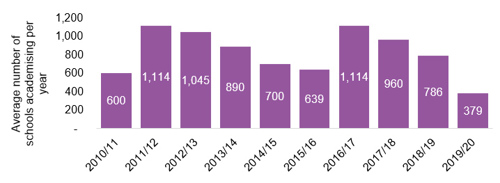Full speed to a fully academised system?
Thursday 1 December 2022
 I recently took part in a panel discussion at the School and Academies Show. The context for the session was the Government’s recent Schools White Paper, which was published in March 2022.
I recently took part in a panel discussion at the School and Academies Show. The context for the session was the Government’s recent Schools White Paper, which was published in March 2022.
The discussion focused on what challenges schools and trusts face over the next decade and how they can start to work towards the 2030 targets. I have found myself contemplating the discussion a lot since and have shared some reflections below.
Will full academisation be achieved by 2030?
One of the key ambitions set out in the White Paper is that ‘All children will benefit from being taught in a family of schools, with their school in a strong multi academy trust or with plans to join or form one by 2030’. The panel started by considering whether this ambition would be achieved. It was noted that there has clearly been much political turmoil since March and it remains to be seen whether the new Sunak Government will commit to the White Paper in full or in part, or, given there will be an election by January 2025, what Labour would do were they to get into power.
Notwithstanding this, a few panel members felt that we will achieve full academisation or be close by 2030 - not because of the Government’s aim per se, but for a range of other reasons such as the benefits afforded to schools operating within a wider group, or because local authorities (LAs) were no longer able to support their schools.
I however am uncertain as to whether the ambition would be achieved. With little over half of mainstream schools (53%) still under LA control, in terms of numbers alone, it will be very challenging as this would mean around 1,300 mainstream schools becoming an academy each year until 2030. If we assumed this academisation were to be spread evenly across the year [1], this equates to about 25 mainstream schools academising each and every week until the end of 2030. As Figure 1 below shows, this is would be at a faster rate than seen in previous years, even in the early years of the programme.
Figure 1: Number of LA schools that are academising each year

Source: DfE academies sector annual reports - Note: Based on academy financial year (August to July). Data not yet available for 2020/21.
Bearing in mind that many of the LA schools who wanted to become an academy will have already done so, those who haven’t may be more reluctant or unpersuaded about the benefits of academisation. Given the current political uncertainty, some may decide to bide their time and see what the outcome of the next election is before deciding what to do. If this happens in large numbers, the scale of the challenge to get all schools into a strong MAT by 2030 will be even greater.
Of tipping points
One of the factors suggested by some of the panellists in the debate was that we are approaching a tipping point. With over half of children in state education now being educated in academies in a school trust, it was suggested that the direction of travel towards a fully academised system was becoming clear.
This concept of a tipping point has been around for several years, although my understanding had been that it referred to when a local authority reached its tipping point, rather than when the system as a whole had. This raised questions in my mind about whether there should be a system-wide tipping point.
Some areas of the country see the vast majority of their schools no longer under LA control. I can certainly understand why questions arise around whether and when an LA might reach a tipping point as the costs of supporting the remaining schools start to rise considerably as economies of scale are eroded. But what about the other areas of the country where there is still a long way to go to achieve full academisation?
There is also a question about whether LAs who control reducing numbers of schools want to push their schools towards academisation and potentially set up their own trust as per the possibilities announced in the White Paper. Again, we do not yet have any evidence about this, but NFER will be publishing new research which explores this further in January 2023.
Schools need more evidence and information
Making the decision about academising and joining a trust is hugely important for LA schools as they cannot row back if they don’t like the trust they have joined. Yet there is still much that we do not know. While the Schools White Paper describes some of the features of what a strong trust might look like, we are still waiting for the Government to define in more detail exactly what this is. It is also not clear how much choice LA schools will really have, given that the Government may decide to limit the number of new trusts.
There is a lack of evidence about trusts, including matters such as which school trust operating models are most effective and what the optimal trust size should be. The Government’s ambition is for all schools to be in a trust of at least 10 schools or 7,500 pupils, but there is, so far, a lack of evidence suggesting this will improve pupil outcomes.
These are just a few of the areas in which more information and research are needed. To ensure we have a strong school system going forward, it is imperative more research is carried out to increase confidence and ensure school funding is being used as effectively as possible.
References
[1] This assumption is purely for illustrative purposes - most schools become an academy at concentrated times in the year.
